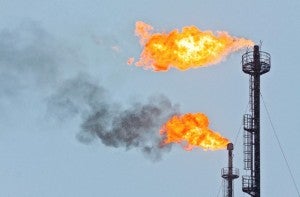 Nearly every month, for the past six months, a new scientific study has been released that provides new insights in to where methane, a highly potent, climate-destabilizing greenhouse gas, could be reduced across the entire natural gas system – the next six months will be no different. But this week, a new joint Purdue-Cornell study published in the Proceedings of the National Academy of Sciences revealed high emissions from drilling.
Nearly every month, for the past six months, a new scientific study has been released that provides new insights in to where methane, a highly potent, climate-destabilizing greenhouse gas, could be reduced across the entire natural gas system – the next six months will be no different. But this week, a new joint Purdue-Cornell study published in the Proceedings of the National Academy of Sciences revealed high emissions from drilling.
The study reports very high methane emissions during the pre-production phase of developing natural gas. Purdue scientists flew an instrumented aircraft in close proximity to a relatively small but intensive oil and gas producing area of Pennsylvania (roughly 2,800 square kilometers), in order to collect atmospheric methane concentration data. Charting a flight path that took the plane both up-wind and down-wind of an area with previously observed methane plumes, the researchers were able to attribute high methane emissions to the actual process of drilling a well, before any hydraulic fracturing or production had taken place – phases more commonly associated with the greatest share of production emissions. The researchers also reported data that further validates the presence of “super-emitters” (a small number of sources that represent the largest portion of emissions).Their results were based on observations made of seven well pads, using data from aerial measurements taken on two days.
The Purdue aircraft team, led by Paul Shepson, is one of a small number of groups conducting research from the air with the objective of determining the emissions from individual sites, multiple sites or broad geographic regions. It’s an approach that Shepson is also bringing to the Barnett Campaign, one of the 16 EDF-initiated methane studies including a broad aerial measurement component. Four of the 12 research teams in this project specialize in a variety of aircraft-based techniques to measure emissions that are being layered in with other measurements teams gathered through vehicle and ground-based techniques. The idea is to apply multiple approaches to measuring methane in one place, at one time as a way to compare methodologies and gain new insights, including a better understanding of the differences between top-down and bottom-up techniques.
The Purdue-Cornell paper contributes to our growing understanding of human-caused methane emissions in the United States. While there are often differences among emissions reported by different studies, with variability observed between individual well sites and specific regions, they all support a pair of conclusions: methane emissions are a problem and there are viable solutions available. This includes the September 2013 University of Texas study – the first in EDF’s coordinated series that reported the results of some of the first direct measurements ever taken at hydraulically fractured well sites. Though the study found total emissions for the natural gas production segment were similar to EPA’s estimates in 2011 it revealed that emissions were much higher than estimated for some specific sources – valves, compressors, and pipes located at the well pad. The study also found emissions during “well completions”, after hydraulic fracturing when a well is cleared of liquids to allow production to begin, were dramatically lower when reduced emissions completions (RECs) were deployed. In 2012, when the measurements were made, drillers were accelerating deployment of REC equipment that was required by EPA late in 2012.
Conducting science to clarify our understanding is challenging work. It often takes time to define a problem and for enough data to be collected to ensure that differing insights converge. On the issue of methane emissions from the natural gas supply chain the scientific evidence is growing quickly, thus the call for action is getting louder. At the same time we’re beginning to see that effective policy is taking shape in leading states and at the federal level. The Purdue-Cornell study is yet another study that shows methane emissions from oil and gas operations is an urgent issue to address and that continued state and federal action is needed to reduce it.









